-
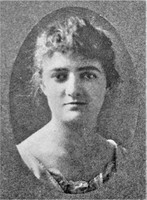 Madge Oberholtzer
Madge Oberholtzer Madge Oberholtzer (1897–1925) as seen in the 1917 issue of The Drift, the Butler University student yearbook. After graduating from Manual High School—located then on the near south side of downtown Indianapolis—Oberholtzer attended Butler University on its Irvington campus from the fall of 1914 until 1917. As a student she was a member of the Pi Beta Phi Sorority. Oberholtzer worked as the manager of the Indiana Young People’s Reading Circle, a special section of the Indiana Department of Public Instruction.
-
 September 15, 1948, Board of Directors’ Executive Committee Meeting Minutes
September 15, 1948, Board of Directors’ Executive Committee Meeting Minutes September 15, 1948, Board of Directors’ Executive Committee Meeting Minutes. The quota on Black students at Butler University ran from 1927—a year prior to the University’s move to its current campus—until 1948. The University’s Board of Directors meeting minutes provide no detail behind why the quota was started. This excerpt is from September 15, 1948, when the Executive Committee initially voted to rescind the quota: Dr. Ross presented the following resolution and moved its adoption. Be it resolved, that the Executive Committee recommend to the Board of Directors at their next regular meeting that a resolution be passed that no discrimination should be made against students desiring to enter Butler University on account of their race or religion and that all action discriminating against race or religion heretofore made, if any, is hereby set aside and declared void. Mr. James seconded the motion. All voted with the exception of Mr. Brown, voting “no”, and Mr. Reilly not voting."
-
 October 13, 1948, Board of Directors Meeting Minutes, Page 218
October 13, 1948, Board of Directors Meeting Minutes, Page 218 October 13, 1948, Board of Directors Meeting Minutes, Page 218. The quota on Black students at Butler University ran from 1927—a year prior to the University’s move to its current campus—until 1948. The University’s Board of Directors meeting minutes provide no detail behind why the quota was started. This excerpt is from October 13, 1948, when the quota was officially abolished: (Page 217) Mr. Brown asked Mr. Emsley W. Johnson, Chairman of the Executive Committee to make a report for that Committee. Mr. Johnson stated: "At a meeting of the Executive Committee held upon the 15th day of September, 1948, the following resolution was passed:
Be it resolved, that the Executive Committee recommend to the Board of Directors at their next regular meeting that a resolution be passed to the effect that no discrimination should be made against students desiring to enter Butler University on account of their race or religion and that all action discriminating against race or religion heretofore made, if any, is hereby set aside and declared void.
(Page 218) I therefore move the adoption of the following resolution:
Be it resolved, that no discrimination should be made against students desiring to enter Butler University on account of their race or religion and that all action discriminating against race or religion heretofore made, if any, be hereby set aside and the same be now declared void."
Mr. Walker seconded the motion and all voted aye."
-
 October 13, 1948, Board of Directors Meeting Minutes, Page 217
October 13, 1948, Board of Directors Meeting Minutes, Page 217 October 13, 1948, Board of Directors Meeting Minutes, Page 217. The quota on Black students at Butler University ran from 1927—a year prior to the University’s move to its current campus—until 1948. The University’s Board of Directors meeting minutes provide no detail behind why the quota was started. This excerpt is from October 13, 1948, when the quota was officially abolished: (Page 217) Mr. Brown asked Mr. Emsley W. Johnson, Chairman of the Executive Committee to make a report for that Committee. Mr. Johnson stated: "At a meeting of the Executive Committee held upon the 15th day of September, 1948, the following resolution was passed:
Be it resolved, that the Executive Committee recommend to the Board of Directors at their next regular meeting that a resolution be passed to the effect that no discrimination should be made against students desiring to enter Butler University on account of their race or religion and that all action discriminating against race or religion heretofore made, if any, is hereby set aside and declared void.
(Page 218) I therefore move the adoption of the following resolution:
Be it resolved, that no discrimination should be made against students desiring to enter Butler University on account of their race or religion and that all action discriminating against race or religion heretofore made, if any, be hereby set aside and the same be now declared void."
Mr. Walker seconded the motion and all voted aye."
-
 July 13, 1927, Board of Directors Meeting Minutes
July 13, 1927, Board of Directors Meeting Minutes [Content Warning: Please be advised that the language related to race used in this excerpt from the Butler University Board of Directors (Board of Trustees) meeting minutes is racist and offensive and may cause distress. We are providing record of this excerpt for historical documentation and transparency on the issue of the quota at Butler University. If the viewer wishes to skip the entry, please move to the next part of the exhibit.]July 13, 1927, Board of Directors Meeting Minutes. The quota on Black students at Butler University ran from 1927—a year prior to the University’s move to its current campus—until 1948. The University’s Board of Directors meeting minutes provide no detail behind why the quota was started. This excerpt is from July 13, 1927, when the quota was instituted: "The problem of taking care of colored students at the college was again discussed and on motion of Mr. Burns, seconded by Mr. Irwin, the following resolution was unaminously [sic] adopted. RESOLVED: That all colored students who may be enrolled at Butler College at this time except those in the College of Religion shall be permitted – if they make proper grades – to graduate, and that each year, beginning with the term of September 1927, not over ten additional colored students may be admitted. Before being admitted all such students shall pass such examinations as may be required by a committee of the faculty to be appointed by the president, and to include the Dean of men, the Dean of women and the director of physical education."
-
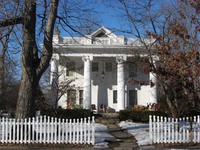 The D. C. Stephenson House
The D. C. Stephenson House In 1923 D. C. Stephenson bought a house in the town of Irvington on the east side of Indianapolis. Built in 1889 the house sat within walking distance to the Butler University campus and had previously served as the home of a Civil War colonel’s family and later the house for Kappa Kappa Gamma Sorority. Stephenson remodeled the home, primarily adding a front portico with four two-story columns, to resemble the Ku Klux Klan’s national headquarters located in Atlanta, Georgia. The house is now on the National Register of Historic Places as the William H. H. Graham House and is privately owned.
-
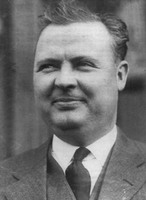 D. C. Stephenson
D. C. Stephenson D. C. Stephenson (1891–1966) served as the Grand Dragon of the Indiana branch of the Ku Klux Klan from 1923 to 1925. During his Klan involvement, Stephenson held considerable power in Indiana politics—over half of the Indiana General Assembly, including the State’s Governor, were Klan affiliated—and held influence throughout the Midwest. In 1925 he raped and murdered a young woman named Madge Oberholtzer. The resulting trial led to Stephenson’s conviction and imprisonment as well as the demise of the second wave of the Klan in the United States, which lasted from approximately 1915 to the late 1920s. The first Klan existed during the Civil War through the beginning of the Reconstruction period (circa 1861–1871), and the third Klan came about during the 1950s and still exists today.
-
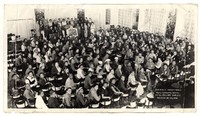 24th Boulé, 1956, Washington D.C.
24th Boulé, 1956, Washington D.C. 24th Boulé, 1956, Washington D.C.
-
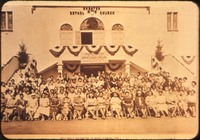 26th Boulé, 1959, Miami, Florida
26th Boulé, 1959, Miami, Florida 26th Boulé, 1959, Miami, Florida
-
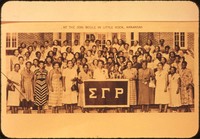 20th Boulé, 1949, Little Rock, Arkansas
20th Boulé, 1949, Little Rock, Arkansas 20th Boulé, 1949, Little Rock, Arkansas
-
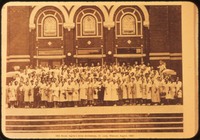 19th Boulé, 1947, St. Louis, Missouri
19th Boulé, 1947, St. Louis, Missouri 19th Boulé, 1947, St. Louis, Missouri
-
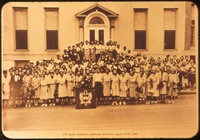 17th Boulé, 1946, Baltimore, Maryland
17th Boulé, 1946, Baltimore, Maryland 17th Boulé, 1946, Baltimore, Maryland
-
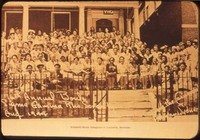 16th Boulé, 1944, Louisville, Kentucky
16th Boulé, 1944, Louisville, Kentucky 16th Boulé, 1944, Louisville, Kentucky
-
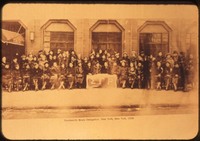 14th Boulé, 1939, New York City
14th Boulé, 1939, New York City 14th Boulé, 1939, New York City
-
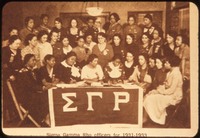 Sigma Gamma Rho Officers, 1933
Sigma Gamma Rho Officers, 1933 Group of Sigma Gamma Rho officers that served from 1931 to 1933. These women would have taken office after Sigma Gamma Rho became a collegiate sorority and had its articles of incorporation approved in 1929 and officially amended in 1930. The photo was taken at the 8th Boulé, 1933, Chicago, Illinois.
-
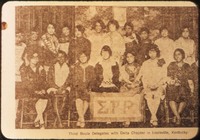 3rd Boulé, 1927, Louisville, Kentucky
3rd Boulé, 1927, Louisville, Kentucky 3rd Boulé, 1927, Louisville, Kentucky
-
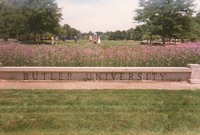 Sigma Gamma Rho Sorors on Butler University's Campus, 1997
Sigma Gamma Rho Sorors on Butler University's Campus, 1997 Sigma Gamma Rho sorors walking along a campus sidewalk with the Butler University sign in the foreground. This photo was taken in 1997 during the 75th anniversary activities.
-
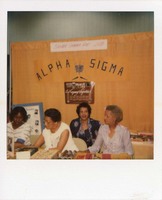 Sigma Gamma Rho Alpha Chapter Booth at 1982 Boulé
Sigma Gamma Rho Alpha Chapter Booth at 1982 Boulé The Alpha Chapter of Sigma Gamma Rho, located at Butler University, has not always been active through the years. Alpha Sigma is the Indianapolis chapter for Sorority alumnae, and it provides support to the Alpha Chapter on campus. The Alpha Sigma Chapter was founded in 1955. This photo shows a booth for the Alpha Sigma Alumnae Chapter at Sigma Gamma Rho’s 1982 Boulé.
-
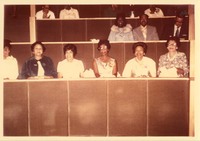 Sigma Gamma Rho Founders at 1972 Boulé
Sigma Gamma Rho Founders at 1972 Boulé Five of the seven Sigma Gamma Rho Founders at the 1972 Boulé. Pictured from left to right are Dorothy Hanley (Whiteside), Mary Lou Allison (Little), Hattie Mae Dulin (Redford), Nannie Mae Gahn (Johnson), and Vivian Irene White (Marbury).
-
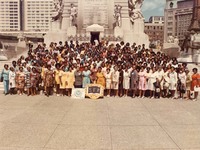 Group of Sorors, 50th Anniversary Boulé
Group of Sorors, 50th Anniversary Boulé 50th Golden Anniversary Boulé, 1972, Indianapolis, Indiana. Sorors who attended pose on Monument Circle in downtown Indianapolis in front of the Soldiers and Sailors Monument.
-
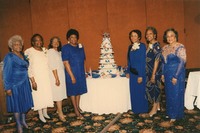 Sigma Gamma Rho Grand Basilei, 1997
Sigma Gamma Rho Grand Basilei, 1997 Several past and serving Sigma Gamma Rho Grand Basilei standing around the cake celebrating the Sorority’s 75th anniversary during festivities in 1997. From left to right, Dr. Cleo S. Higgins (1962–1963), Dr. Annie Lawrence-Brown (1971–1976), Dr. Alice M. Swain (1980–1984), Corine J. Green (1992–1996), Dr. LaRona J. Morris (1996–2000), Dr. Katie White (1988–1992), and Evelyn Hood (1976–1980).
-
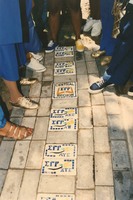 Sigma Gamma Rho 75th Anniversary Walking Path
Sigma Gamma Rho 75th Anniversary Walking Path A walking path commemorating the chapters of Sigma Gamma Rho entitled Lifetime Legacy Lane. The path was made in 1997 as part of the 75th anniversary of the Sorority and is located outside Atherton Union at Butler University.
-
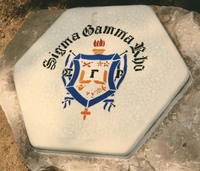 Sigma Gamma Rho Sorority Mosaic Crest
Sigma Gamma Rho Sorority Mosaic Crest This mosaic plaque of the Sigma Gamma Rho crest can be found on a rock in the Sigma Gamma Rho memorial walk dedicated during the 75th Diamond Jubilee in 1997 on Butler University’s campus.
-
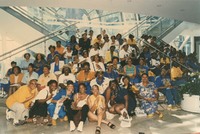 Sigma Gamma Rho Sorors at Indianapolis Artsgarden, 1997
Sigma Gamma Rho Sorors at Indianapolis Artsgarden, 1997 75th Diamond Jubilee, 1997, Indianapolis, Indiana. Sorors pose on the steps of the Indianapolis Artsgarden in downtown Indianapolis.
-
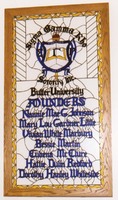 Sigma Gamma Rho 75th Anniversary Stained Glass Window
Sigma Gamma Rho 75th Anniversary Stained Glass Window The stained glass window made in honor of the Founders of Sigma Gamma Rho entitled Stained Glass Silhouettes. The window was made in 1997 as part of the 75th anniversary of the Sorority and now hangs in Atherton Union at Butler University.
-
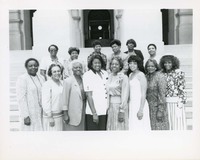 Sigma Gamma Rho Sorors and Grand Basilei, circa 1990s
Sigma Gamma Rho Sorors and Grand Basilei, circa 1990s Sigma Gamma Rho members and Grand Basilei. The first row includes Dr. Annie Lawrence-Brown (1971–1976), Evelyn Hood (1976–1980), Dr. Cleo S. Higgins (1962–1963), Corine J. Green (1992–1996), Dr. Katie White (1988–1992), Soror Diane Houslin, Dr. Alice M. Swain (1980–1984), and Dr. Rejesta Perry (1984–1988).
-
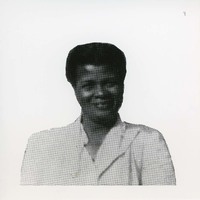 Bessie May Downey
Bessie May Downey Bessie May Downey (Rhodes) (Martin) passed the normal training school examination in 1916. While studying for her teaching degree, Downey had also been caring for her ailing mother, who had worked hard to help pay for her daughter’s education. In 1918 Downey accepted a teaching position with IPS at William D. McCoy School (No. 24). Her mother lived to see her daughter’s career begin but she died shortly thereafter. Downey earned a Bachelor of Science in Education from Butler in 1943 and died in May 1947, having been a teacher in the same school throughout her career.
-
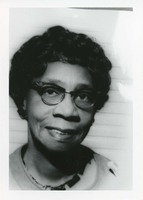 Hattie Mae Dulin
Hattie Mae Dulin Hattie Mae Dulin (Redford) grew up in South Bend, Indiana. In 1920 she earned a Bachelor of Science from Indiana State Normal School (today Indiana State University) and a Master of Science in Education from Butler in 1939. She wrote her thesis about student government in the elementary schools of Indianapolis. After teaching one year in Terre Haute, Dulin spent 37 years with IPS. She retired from School No. 37 in 1958. Dulin died in July 1990.
-
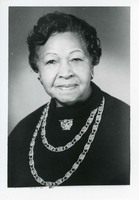 Dorothy Hanley
Dorothy Hanley Dorothy Hanley (Whiteside), a native of Tennessee, graduated from Shortridge High School in 1922. While attending high school Hanley worked as a newspaper carrier for the Indianapolis News. When she started her job in 1914, she was the first female carrier for the newspaper. Hanley was training to be a teacher when she met the other founders. During her career she taught in North Vernon, Indiana, and IPS Schools Nos. 4, 26, 37, and 87. She earned a Bachelor of Science in Education from Butler in 1942. She retired from teaching in 1970. Hanley died in June 1985.
-
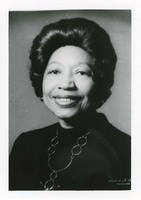 Nannie Mae Gahn
Nannie Mae Gahn Nannie Mae Gahn (Foster) (Johnson) designed the Sorority’s official pin. She enrolled at Butler as a transfer student in 1925. She earned a Bachelor of Science Degree in 1932 and a Master of Science in Education in 1941. Gahn’s teaching career began in 1923 at IPS School No. 23. In 1948 she became assistant principal at School No. 26 and later served as principal at School No. 37 for ten years. Gahn retired in 1966; she died 20 years later.
-
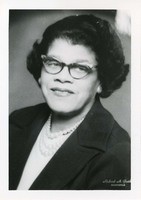 Vivian Irene White
Vivian Irene White Vivian Irene White (Marbury) graduated from Shortridge High School in 1917 and then earned her degree from the Indianapolis Normal School. Her distinguished career with IPS included becoming one of its first female and black principals. For 39 years she was principal at School No. 87. While working full time she earned her Bachelor of Science degree from Butler in 1931. White helped to establish the Butler Minority Alumni Council and was a charter member. The University awarded the Butler Medal, the highest honor given to alumni, to White in recognition of her service to the community and the world. She died in July 2000.
-
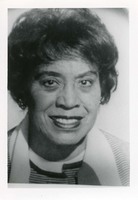 Mary Lou Allison
Mary Lou Allison Mary Lou Allison (Gardner) (Little) is recognized by SGRho as its primary founder. A 1915 graduate of Shortridge High School, Allison earned her teaching certificate from the Indianapolis Normal School in 1918. Her career began in the Indianapolis Public Schools (IPS). She attended Butler University part time from 1919 to 1924. Her many contributions to SGRho include authoring the pledge in 1925 and serving as the first Grand Basileus (national president) from 1925 to 1926. She taught in the Los Angeles Unified School District for 35 years, retiring in 1967. Allison died in March 1992. At each Boulé the Mary Lou Allison Little Loving Cup Award is presented to the Sorority’s most outstanding chapter.
-
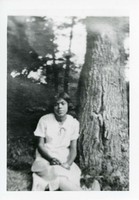 Cubena McClure
Cubena McClure Cubena McClure began teaching in the IPS at Schools Nos. 24 and 26. She hosted the Sorority’s first initiation in her home following the December 1922 incorporation. She also assisted Nannie Mae Gahn in designing the Sorority’s pin. In 1923 she attended Butler College for one term. As her teaching career flourished, McClure received a Gregg Scholarship, dedicated to advancing professional training for recipients, from IPS. It was designated for use at Columbia University. She would not get the chance, however, as she died a few weeks after an operation for appendicitis in August 1924.
-
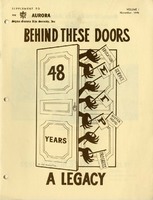 The Aurora
The Aurora The Aurora is the official publication of Sigma Gamma Rho. It was started by Blanche Stewart in 1927 with its first editor in chief being Gertrude Murchison. “Behind These Doors: A Legacy”—or also titled on the title page as “Our Heritage: Glimpses of Highlights”—was a special supplement published in 1970 commemorating the 40th year of the publication and the 48th anniversary of the Sorority. The supplement documents the history of the Sorority and its members.
-
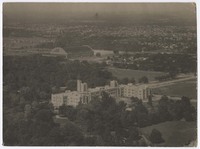 Fairview Campus
Fairview Campus Butler University opened for classes on its current campus in 1928. The early campus consisted of one academic building, an athletic complex with a basketball court and football stadium, and a few additional buildings. From bottom to top in the photograph there is the defunct trolley railroad track, the old Campus Club building—which was relocated from the Irvington campus—Jordan Hall, and the Butler Fieldhouse off in the distance.
-
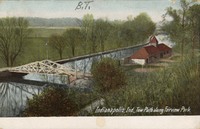 Fairview Park
Fairview Park Butler University’s current campus was once home to Fairview Park, a popular trolley park. In addition to walking paths in a quiet nature setting, Fairview Park offered such varieties of entertainment as boat rides, a bowling alley, and pony rides. The postcard depicts some scenes from the park.
-
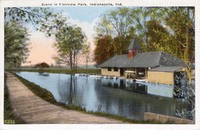 Fairview Park
Fairview Park Butler University’s current campus was once home to Fairview Park, a popular trolley park. In addition to walking paths in a quiet nature setting, Fairview Park offered such varieties of entertainment as boat rides, a bowling alley, and pony rides. The postcard depicts some scenes from the park.
-
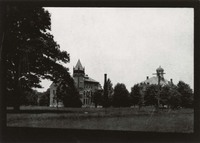 Irvington Campus
Irvington Campus A scenic view of Butler University’s second campus located in Irvington on the east side of Indianapolis. This photograph shows the two academic buildings: Burgess Hall (left) and the Main—or Administration—Building (right).
-
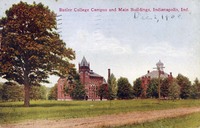 Irvington Campus
Irvington Campus A scenic view of Butler University’s second campus located in Irvington on the east side of Indianapolis. This postcard shows the two academic buildings: Burgess Hall (left) and the Main—or Administration—Building (right).
-
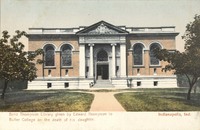 Bona Thompson Memorial Library
Bona Thompson Memorial Library The only remaining building on the site of Butler University's Irvington campus is the Bona Thompson Memorial Library, located at the intersection of University and Downey Avenues. The building was built in 1904 and served as the library until the University’s departure from the Irvington campus in 1928. Today the Irvington Historical Society operates out of the building.
-
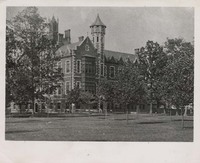 College Avenue Campus
College Avenue Campus The first academic building on the first campus of Butler University—previously North Western Christian University—near 13th Street and College Avenue near downtown Indianapolis. Butler University operated on this campus from 1855 to 1875. The building no longer stands.
-
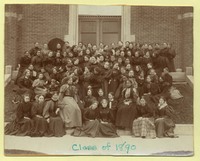 Teachers College of Indianapolis Students, circa 1900
Teachers College of Indianapolis Students, circa 1900 A group of approximately 72 students from the Teachers College of Indianapolis taken around 1900. A handwritten note on the photo reads “Class of 1890.”
-
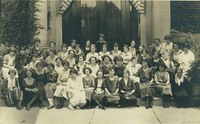 Teachers College of Indianapolis Students, 1922
Teachers College of Indianapolis Students, 1922 A group of students from the Teachers College of Indianapolis taken in 1922.
 Madge Oberholtzer Madge Oberholtzer (1897–1925) as seen in the 1917 issue of The Drift, the Butler University student yearbook. After graduating from Manual High School—located then on the near south side of downtown Indianapolis—Oberholtzer attended Butler University on its Irvington campus from the fall of 1914 until 1917. As a student she was a member of the Pi Beta Phi Sorority. Oberholtzer worked as the manager of the Indiana Young People’s Reading Circle, a special section of the Indiana Department of Public Instruction.
Madge Oberholtzer Madge Oberholtzer (1897–1925) as seen in the 1917 issue of The Drift, the Butler University student yearbook. After graduating from Manual High School—located then on the near south side of downtown Indianapolis—Oberholtzer attended Butler University on its Irvington campus from the fall of 1914 until 1917. As a student she was a member of the Pi Beta Phi Sorority. Oberholtzer worked as the manager of the Indiana Young People’s Reading Circle, a special section of the Indiana Department of Public Instruction. September 15, 1948, Board of Directors’ Executive Committee Meeting Minutes September 15, 1948, Board of Directors’ Executive Committee Meeting Minutes. The quota on Black students at Butler University ran from 1927—a year prior to the University’s move to its current campus—until 1948. The University’s Board of Directors meeting minutes provide no detail behind why the quota was started. This excerpt is from September 15, 1948, when the Executive Committee initially voted to rescind the quota: Dr. Ross presented the following resolution and moved its adoption. Be it resolved, that the Executive Committee recommend to the Board of Directors at their next regular meeting that a resolution be passed that no discrimination should be made against students desiring to enter Butler University on account of their race or religion and that all action discriminating against race or religion heretofore made, if any, is hereby set aside and declared void. Mr. James seconded the motion. All voted with the exception of Mr. Brown, voting “no”, and Mr. Reilly not voting."
September 15, 1948, Board of Directors’ Executive Committee Meeting Minutes September 15, 1948, Board of Directors’ Executive Committee Meeting Minutes. The quota on Black students at Butler University ran from 1927—a year prior to the University’s move to its current campus—until 1948. The University’s Board of Directors meeting minutes provide no detail behind why the quota was started. This excerpt is from September 15, 1948, when the Executive Committee initially voted to rescind the quota: Dr. Ross presented the following resolution and moved its adoption. Be it resolved, that the Executive Committee recommend to the Board of Directors at their next regular meeting that a resolution be passed that no discrimination should be made against students desiring to enter Butler University on account of their race or religion and that all action discriminating against race or religion heretofore made, if any, is hereby set aside and declared void. Mr. James seconded the motion. All voted with the exception of Mr. Brown, voting “no”, and Mr. Reilly not voting." October 13, 1948, Board of Directors Meeting Minutes, Page 218 October 13, 1948, Board of Directors Meeting Minutes, Page 218. The quota on Black students at Butler University ran from 1927—a year prior to the University’s move to its current campus—until 1948. The University’s Board of Directors meeting minutes provide no detail behind why the quota was started. This excerpt is from October 13, 1948, when the quota was officially abolished: (Page 217) Mr. Brown asked Mr. Emsley W. Johnson, Chairman of the Executive Committee to make a report for that Committee. Mr. Johnson stated: "At a meeting of the Executive Committee held upon the 15th day of September, 1948, the following resolution was passed: Be it resolved, that the Executive Committee recommend to the Board of Directors at their next regular meeting that a resolution be passed to the effect that no discrimination should be made against students desiring to enter Butler University on account of their race or religion and that all action discriminating against race or religion heretofore made, if any, is hereby set aside and declared void. (Page 218) I therefore move the adoption of the following resolution: Be it resolved, that no discrimination should be made against students desiring to enter Butler University on account of their race or religion and that all action discriminating against race or religion heretofore made, if any, be hereby set aside and the same be now declared void." Mr. Walker seconded the motion and all voted aye."
October 13, 1948, Board of Directors Meeting Minutes, Page 218 October 13, 1948, Board of Directors Meeting Minutes, Page 218. The quota on Black students at Butler University ran from 1927—a year prior to the University’s move to its current campus—until 1948. The University’s Board of Directors meeting minutes provide no detail behind why the quota was started. This excerpt is from October 13, 1948, when the quota was officially abolished: (Page 217) Mr. Brown asked Mr. Emsley W. Johnson, Chairman of the Executive Committee to make a report for that Committee. Mr. Johnson stated: "At a meeting of the Executive Committee held upon the 15th day of September, 1948, the following resolution was passed: Be it resolved, that the Executive Committee recommend to the Board of Directors at their next regular meeting that a resolution be passed to the effect that no discrimination should be made against students desiring to enter Butler University on account of their race or religion and that all action discriminating against race or religion heretofore made, if any, is hereby set aside and declared void. (Page 218) I therefore move the adoption of the following resolution: Be it resolved, that no discrimination should be made against students desiring to enter Butler University on account of their race or religion and that all action discriminating against race or religion heretofore made, if any, be hereby set aside and the same be now declared void." Mr. Walker seconded the motion and all voted aye." October 13, 1948, Board of Directors Meeting Minutes, Page 217 October 13, 1948, Board of Directors Meeting Minutes, Page 217. The quota on Black students at Butler University ran from 1927—a year prior to the University’s move to its current campus—until 1948. The University’s Board of Directors meeting minutes provide no detail behind why the quota was started. This excerpt is from October 13, 1948, when the quota was officially abolished: (Page 217) Mr. Brown asked Mr. Emsley W. Johnson, Chairman of the Executive Committee to make a report for that Committee. Mr. Johnson stated: "At a meeting of the Executive Committee held upon the 15th day of September, 1948, the following resolution was passed: Be it resolved, that the Executive Committee recommend to the Board of Directors at their next regular meeting that a resolution be passed to the effect that no discrimination should be made against students desiring to enter Butler University on account of their race or religion and that all action discriminating against race or religion heretofore made, if any, is hereby set aside and declared void. (Page 218) I therefore move the adoption of the following resolution: Be it resolved, that no discrimination should be made against students desiring to enter Butler University on account of their race or religion and that all action discriminating against race or religion heretofore made, if any, be hereby set aside and the same be now declared void." Mr. Walker seconded the motion and all voted aye."
October 13, 1948, Board of Directors Meeting Minutes, Page 217 October 13, 1948, Board of Directors Meeting Minutes, Page 217. The quota on Black students at Butler University ran from 1927—a year prior to the University’s move to its current campus—until 1948. The University’s Board of Directors meeting minutes provide no detail behind why the quota was started. This excerpt is from October 13, 1948, when the quota was officially abolished: (Page 217) Mr. Brown asked Mr. Emsley W. Johnson, Chairman of the Executive Committee to make a report for that Committee. Mr. Johnson stated: "At a meeting of the Executive Committee held upon the 15th day of September, 1948, the following resolution was passed: Be it resolved, that the Executive Committee recommend to the Board of Directors at their next regular meeting that a resolution be passed to the effect that no discrimination should be made against students desiring to enter Butler University on account of their race or religion and that all action discriminating against race or religion heretofore made, if any, is hereby set aside and declared void. (Page 218) I therefore move the adoption of the following resolution: Be it resolved, that no discrimination should be made against students desiring to enter Butler University on account of their race or religion and that all action discriminating against race or religion heretofore made, if any, be hereby set aside and the same be now declared void." Mr. Walker seconded the motion and all voted aye." July 13, 1927, Board of Directors Meeting Minutes [Content Warning: Please be advised that the language related to race used in this excerpt from the Butler University Board of Directors (Board of Trustees) meeting minutes is racist and offensive and may cause distress. We are providing record of this excerpt for historical documentation and transparency on the issue of the quota at Butler University. If the viewer wishes to skip the entry, please move to the next part of the exhibit.]July 13, 1927, Board of Directors Meeting Minutes. The quota on Black students at Butler University ran from 1927—a year prior to the University’s move to its current campus—until 1948. The University’s Board of Directors meeting minutes provide no detail behind why the quota was started. This excerpt is from July 13, 1927, when the quota was instituted: "The problem of taking care of colored students at the college was again discussed and on motion of Mr. Burns, seconded by Mr. Irwin, the following resolution was unaminously [sic] adopted. RESOLVED: That all colored students who may be enrolled at Butler College at this time except those in the College of Religion shall be permitted – if they make proper grades – to graduate, and that each year, beginning with the term of September 1927, not over ten additional colored students may be admitted. Before being admitted all such students shall pass such examinations as may be required by a committee of the faculty to be appointed by the president, and to include the Dean of men, the Dean of women and the director of physical education."
July 13, 1927, Board of Directors Meeting Minutes [Content Warning: Please be advised that the language related to race used in this excerpt from the Butler University Board of Directors (Board of Trustees) meeting minutes is racist and offensive and may cause distress. We are providing record of this excerpt for historical documentation and transparency on the issue of the quota at Butler University. If the viewer wishes to skip the entry, please move to the next part of the exhibit.]July 13, 1927, Board of Directors Meeting Minutes. The quota on Black students at Butler University ran from 1927—a year prior to the University’s move to its current campus—until 1948. The University’s Board of Directors meeting minutes provide no detail behind why the quota was started. This excerpt is from July 13, 1927, when the quota was instituted: "The problem of taking care of colored students at the college was again discussed and on motion of Mr. Burns, seconded by Mr. Irwin, the following resolution was unaminously [sic] adopted. RESOLVED: That all colored students who may be enrolled at Butler College at this time except those in the College of Religion shall be permitted – if they make proper grades – to graduate, and that each year, beginning with the term of September 1927, not over ten additional colored students may be admitted. Before being admitted all such students shall pass such examinations as may be required by a committee of the faculty to be appointed by the president, and to include the Dean of men, the Dean of women and the director of physical education." The D. C. Stephenson House In 1923 D. C. Stephenson bought a house in the town of Irvington on the east side of Indianapolis. Built in 1889 the house sat within walking distance to the Butler University campus and had previously served as the home of a Civil War colonel’s family and later the house for Kappa Kappa Gamma Sorority. Stephenson remodeled the home, primarily adding a front portico with four two-story columns, to resemble the Ku Klux Klan’s national headquarters located in Atlanta, Georgia. The house is now on the National Register of Historic Places as the William H. H. Graham House and is privately owned.
The D. C. Stephenson House In 1923 D. C. Stephenson bought a house in the town of Irvington on the east side of Indianapolis. Built in 1889 the house sat within walking distance to the Butler University campus and had previously served as the home of a Civil War colonel’s family and later the house for Kappa Kappa Gamma Sorority. Stephenson remodeled the home, primarily adding a front portico with four two-story columns, to resemble the Ku Klux Klan’s national headquarters located in Atlanta, Georgia. The house is now on the National Register of Historic Places as the William H. H. Graham House and is privately owned. D. C. Stephenson D. C. Stephenson (1891–1966) served as the Grand Dragon of the Indiana branch of the Ku Klux Klan from 1923 to 1925. During his Klan involvement, Stephenson held considerable power in Indiana politics—over half of the Indiana General Assembly, including the State’s Governor, were Klan affiliated—and held influence throughout the Midwest. In 1925 he raped and murdered a young woman named Madge Oberholtzer. The resulting trial led to Stephenson’s conviction and imprisonment as well as the demise of the second wave of the Klan in the United States, which lasted from approximately 1915 to the late 1920s. The first Klan existed during the Civil War through the beginning of the Reconstruction period (circa 1861–1871), and the third Klan came about during the 1950s and still exists today.
D. C. Stephenson D. C. Stephenson (1891–1966) served as the Grand Dragon of the Indiana branch of the Ku Klux Klan from 1923 to 1925. During his Klan involvement, Stephenson held considerable power in Indiana politics—over half of the Indiana General Assembly, including the State’s Governor, were Klan affiliated—and held influence throughout the Midwest. In 1925 he raped and murdered a young woman named Madge Oberholtzer. The resulting trial led to Stephenson’s conviction and imprisonment as well as the demise of the second wave of the Klan in the United States, which lasted from approximately 1915 to the late 1920s. The first Klan existed during the Civil War through the beginning of the Reconstruction period (circa 1861–1871), and the third Klan came about during the 1950s and still exists today. 24th Boulé, 1956, Washington D.C. 24th Boulé, 1956, Washington D.C.
24th Boulé, 1956, Washington D.C. 24th Boulé, 1956, Washington D.C. 26th Boulé, 1959, Miami, Florida 26th Boulé, 1959, Miami, Florida
26th Boulé, 1959, Miami, Florida 26th Boulé, 1959, Miami, Florida 20th Boulé, 1949, Little Rock, Arkansas 20th Boulé, 1949, Little Rock, Arkansas
20th Boulé, 1949, Little Rock, Arkansas 20th Boulé, 1949, Little Rock, Arkansas 19th Boulé, 1947, St. Louis, Missouri 19th Boulé, 1947, St. Louis, Missouri
19th Boulé, 1947, St. Louis, Missouri 19th Boulé, 1947, St. Louis, Missouri 17th Boulé, 1946, Baltimore, Maryland 17th Boulé, 1946, Baltimore, Maryland
17th Boulé, 1946, Baltimore, Maryland 17th Boulé, 1946, Baltimore, Maryland 16th Boulé, 1944, Louisville, Kentucky 16th Boulé, 1944, Louisville, Kentucky
16th Boulé, 1944, Louisville, Kentucky 16th Boulé, 1944, Louisville, Kentucky 14th Boulé, 1939, New York City 14th Boulé, 1939, New York City
14th Boulé, 1939, New York City 14th Boulé, 1939, New York City Sigma Gamma Rho Officers, 1933 Group of Sigma Gamma Rho officers that served from 1931 to 1933. These women would have taken office after Sigma Gamma Rho became a collegiate sorority and had its articles of incorporation approved in 1929 and officially amended in 1930. The photo was taken at the 8th Boulé, 1933, Chicago, Illinois.
Sigma Gamma Rho Officers, 1933 Group of Sigma Gamma Rho officers that served from 1931 to 1933. These women would have taken office after Sigma Gamma Rho became a collegiate sorority and had its articles of incorporation approved in 1929 and officially amended in 1930. The photo was taken at the 8th Boulé, 1933, Chicago, Illinois. 3rd Boulé, 1927, Louisville, Kentucky 3rd Boulé, 1927, Louisville, Kentucky
3rd Boulé, 1927, Louisville, Kentucky 3rd Boulé, 1927, Louisville, Kentucky Sigma Gamma Rho Sorors on Butler University's Campus, 1997 Sigma Gamma Rho sorors walking along a campus sidewalk with the Butler University sign in the foreground. This photo was taken in 1997 during the 75th anniversary activities.
Sigma Gamma Rho Sorors on Butler University's Campus, 1997 Sigma Gamma Rho sorors walking along a campus sidewalk with the Butler University sign in the foreground. This photo was taken in 1997 during the 75th anniversary activities. Sigma Gamma Rho Alpha Chapter Booth at 1982 Boulé The Alpha Chapter of Sigma Gamma Rho, located at Butler University, has not always been active through the years. Alpha Sigma is the Indianapolis chapter for Sorority alumnae, and it provides support to the Alpha Chapter on campus. The Alpha Sigma Chapter was founded in 1955. This photo shows a booth for the Alpha Sigma Alumnae Chapter at Sigma Gamma Rho’s 1982 Boulé.
Sigma Gamma Rho Alpha Chapter Booth at 1982 Boulé The Alpha Chapter of Sigma Gamma Rho, located at Butler University, has not always been active through the years. Alpha Sigma is the Indianapolis chapter for Sorority alumnae, and it provides support to the Alpha Chapter on campus. The Alpha Sigma Chapter was founded in 1955. This photo shows a booth for the Alpha Sigma Alumnae Chapter at Sigma Gamma Rho’s 1982 Boulé. Sigma Gamma Rho Founders at 1972 Boulé Five of the seven Sigma Gamma Rho Founders at the 1972 Boulé. Pictured from left to right are Dorothy Hanley (Whiteside), Mary Lou Allison (Little), Hattie Mae Dulin (Redford), Nannie Mae Gahn (Johnson), and Vivian Irene White (Marbury).
Sigma Gamma Rho Founders at 1972 Boulé Five of the seven Sigma Gamma Rho Founders at the 1972 Boulé. Pictured from left to right are Dorothy Hanley (Whiteside), Mary Lou Allison (Little), Hattie Mae Dulin (Redford), Nannie Mae Gahn (Johnson), and Vivian Irene White (Marbury). Group of Sorors, 50th Anniversary Boulé 50th Golden Anniversary Boulé, 1972, Indianapolis, Indiana. Sorors who attended pose on Monument Circle in downtown Indianapolis in front of the Soldiers and Sailors Monument.
Group of Sorors, 50th Anniversary Boulé 50th Golden Anniversary Boulé, 1972, Indianapolis, Indiana. Sorors who attended pose on Monument Circle in downtown Indianapolis in front of the Soldiers and Sailors Monument. Sigma Gamma Rho Grand Basilei, 1997 Several past and serving Sigma Gamma Rho Grand Basilei standing around the cake celebrating the Sorority’s 75th anniversary during festivities in 1997. From left to right, Dr. Cleo S. Higgins (1962–1963), Dr. Annie Lawrence-Brown (1971–1976), Dr. Alice M. Swain (1980–1984), Corine J. Green (1992–1996), Dr. LaRona J. Morris (1996–2000), Dr. Katie White (1988–1992), and Evelyn Hood (1976–1980).
Sigma Gamma Rho Grand Basilei, 1997 Several past and serving Sigma Gamma Rho Grand Basilei standing around the cake celebrating the Sorority’s 75th anniversary during festivities in 1997. From left to right, Dr. Cleo S. Higgins (1962–1963), Dr. Annie Lawrence-Brown (1971–1976), Dr. Alice M. Swain (1980–1984), Corine J. Green (1992–1996), Dr. LaRona J. Morris (1996–2000), Dr. Katie White (1988–1992), and Evelyn Hood (1976–1980). Sigma Gamma Rho 75th Anniversary Walking Path A walking path commemorating the chapters of Sigma Gamma Rho entitled Lifetime Legacy Lane. The path was made in 1997 as part of the 75th anniversary of the Sorority and is located outside Atherton Union at Butler University.
Sigma Gamma Rho 75th Anniversary Walking Path A walking path commemorating the chapters of Sigma Gamma Rho entitled Lifetime Legacy Lane. The path was made in 1997 as part of the 75th anniversary of the Sorority and is located outside Atherton Union at Butler University. Sigma Gamma Rho Sorority Mosaic Crest This mosaic plaque of the Sigma Gamma Rho crest can be found on a rock in the Sigma Gamma Rho memorial walk dedicated during the 75th Diamond Jubilee in 1997 on Butler University’s campus.
Sigma Gamma Rho Sorority Mosaic Crest This mosaic plaque of the Sigma Gamma Rho crest can be found on a rock in the Sigma Gamma Rho memorial walk dedicated during the 75th Diamond Jubilee in 1997 on Butler University’s campus. Sigma Gamma Rho Sorors at Indianapolis Artsgarden, 1997 75th Diamond Jubilee, 1997, Indianapolis, Indiana. Sorors pose on the steps of the Indianapolis Artsgarden in downtown Indianapolis.
Sigma Gamma Rho Sorors at Indianapolis Artsgarden, 1997 75th Diamond Jubilee, 1997, Indianapolis, Indiana. Sorors pose on the steps of the Indianapolis Artsgarden in downtown Indianapolis. Sigma Gamma Rho 75th Anniversary Stained Glass Window The stained glass window made in honor of the Founders of Sigma Gamma Rho entitled Stained Glass Silhouettes. The window was made in 1997 as part of the 75th anniversary of the Sorority and now hangs in Atherton Union at Butler University.
Sigma Gamma Rho 75th Anniversary Stained Glass Window The stained glass window made in honor of the Founders of Sigma Gamma Rho entitled Stained Glass Silhouettes. The window was made in 1997 as part of the 75th anniversary of the Sorority and now hangs in Atherton Union at Butler University. Sigma Gamma Rho Sorors and Grand Basilei, circa 1990s Sigma Gamma Rho members and Grand Basilei. The first row includes Dr. Annie Lawrence-Brown (1971–1976), Evelyn Hood (1976–1980), Dr. Cleo S. Higgins (1962–1963), Corine J. Green (1992–1996), Dr. Katie White (1988–1992), Soror Diane Houslin, Dr. Alice M. Swain (1980–1984), and Dr. Rejesta Perry (1984–1988).
Sigma Gamma Rho Sorors and Grand Basilei, circa 1990s Sigma Gamma Rho members and Grand Basilei. The first row includes Dr. Annie Lawrence-Brown (1971–1976), Evelyn Hood (1976–1980), Dr. Cleo S. Higgins (1962–1963), Corine J. Green (1992–1996), Dr. Katie White (1988–1992), Soror Diane Houslin, Dr. Alice M. Swain (1980–1984), and Dr. Rejesta Perry (1984–1988). Bessie May Downey Bessie May Downey (Rhodes) (Martin) passed the normal training school examination in 1916. While studying for her teaching degree, Downey had also been caring for her ailing mother, who had worked hard to help pay for her daughter’s education. In 1918 Downey accepted a teaching position with IPS at William D. McCoy School (No. 24). Her mother lived to see her daughter’s career begin but she died shortly thereafter. Downey earned a Bachelor of Science in Education from Butler in 1943 and died in May 1947, having been a teacher in the same school throughout her career.
Bessie May Downey Bessie May Downey (Rhodes) (Martin) passed the normal training school examination in 1916. While studying for her teaching degree, Downey had also been caring for her ailing mother, who had worked hard to help pay for her daughter’s education. In 1918 Downey accepted a teaching position with IPS at William D. McCoy School (No. 24). Her mother lived to see her daughter’s career begin but she died shortly thereafter. Downey earned a Bachelor of Science in Education from Butler in 1943 and died in May 1947, having been a teacher in the same school throughout her career. Hattie Mae Dulin Hattie Mae Dulin (Redford) grew up in South Bend, Indiana. In 1920 she earned a Bachelor of Science from Indiana State Normal School (today Indiana State University) and a Master of Science in Education from Butler in 1939. She wrote her thesis about student government in the elementary schools of Indianapolis. After teaching one year in Terre Haute, Dulin spent 37 years with IPS. She retired from School No. 37 in 1958. Dulin died in July 1990.
Hattie Mae Dulin Hattie Mae Dulin (Redford) grew up in South Bend, Indiana. In 1920 she earned a Bachelor of Science from Indiana State Normal School (today Indiana State University) and a Master of Science in Education from Butler in 1939. She wrote her thesis about student government in the elementary schools of Indianapolis. After teaching one year in Terre Haute, Dulin spent 37 years with IPS. She retired from School No. 37 in 1958. Dulin died in July 1990. Dorothy Hanley Dorothy Hanley (Whiteside), a native of Tennessee, graduated from Shortridge High School in 1922. While attending high school Hanley worked as a newspaper carrier for the Indianapolis News. When she started her job in 1914, she was the first female carrier for the newspaper. Hanley was training to be a teacher when she met the other founders. During her career she taught in North Vernon, Indiana, and IPS Schools Nos. 4, 26, 37, and 87. She earned a Bachelor of Science in Education from Butler in 1942. She retired from teaching in 1970. Hanley died in June 1985.
Dorothy Hanley Dorothy Hanley (Whiteside), a native of Tennessee, graduated from Shortridge High School in 1922. While attending high school Hanley worked as a newspaper carrier for the Indianapolis News. When she started her job in 1914, she was the first female carrier for the newspaper. Hanley was training to be a teacher when she met the other founders. During her career she taught in North Vernon, Indiana, and IPS Schools Nos. 4, 26, 37, and 87. She earned a Bachelor of Science in Education from Butler in 1942. She retired from teaching in 1970. Hanley died in June 1985. Nannie Mae Gahn Nannie Mae Gahn (Foster) (Johnson) designed the Sorority’s official pin. She enrolled at Butler as a transfer student in 1925. She earned a Bachelor of Science Degree in 1932 and a Master of Science in Education in 1941. Gahn’s teaching career began in 1923 at IPS School No. 23. In 1948 she became assistant principal at School No. 26 and later served as principal at School No. 37 for ten years. Gahn retired in 1966; she died 20 years later.
Nannie Mae Gahn Nannie Mae Gahn (Foster) (Johnson) designed the Sorority’s official pin. She enrolled at Butler as a transfer student in 1925. She earned a Bachelor of Science Degree in 1932 and a Master of Science in Education in 1941. Gahn’s teaching career began in 1923 at IPS School No. 23. In 1948 she became assistant principal at School No. 26 and later served as principal at School No. 37 for ten years. Gahn retired in 1966; she died 20 years later. Vivian Irene White Vivian Irene White (Marbury) graduated from Shortridge High School in 1917 and then earned her degree from the Indianapolis Normal School. Her distinguished career with IPS included becoming one of its first female and black principals. For 39 years she was principal at School No. 87. While working full time she earned her Bachelor of Science degree from Butler in 1931. White helped to establish the Butler Minority Alumni Council and was a charter member. The University awarded the Butler Medal, the highest honor given to alumni, to White in recognition of her service to the community and the world. She died in July 2000.
Vivian Irene White Vivian Irene White (Marbury) graduated from Shortridge High School in 1917 and then earned her degree from the Indianapolis Normal School. Her distinguished career with IPS included becoming one of its first female and black principals. For 39 years she was principal at School No. 87. While working full time she earned her Bachelor of Science degree from Butler in 1931. White helped to establish the Butler Minority Alumni Council and was a charter member. The University awarded the Butler Medal, the highest honor given to alumni, to White in recognition of her service to the community and the world. She died in July 2000. Mary Lou Allison Mary Lou Allison (Gardner) (Little) is recognized by SGRho as its primary founder. A 1915 graduate of Shortridge High School, Allison earned her teaching certificate from the Indianapolis Normal School in 1918. Her career began in the Indianapolis Public Schools (IPS). She attended Butler University part time from 1919 to 1924. Her many contributions to SGRho include authoring the pledge in 1925 and serving as the first Grand Basileus (national president) from 1925 to 1926. She taught in the Los Angeles Unified School District for 35 years, retiring in 1967. Allison died in March 1992. At each Boulé the Mary Lou Allison Little Loving Cup Award is presented to the Sorority’s most outstanding chapter.
Mary Lou Allison Mary Lou Allison (Gardner) (Little) is recognized by SGRho as its primary founder. A 1915 graduate of Shortridge High School, Allison earned her teaching certificate from the Indianapolis Normal School in 1918. Her career began in the Indianapolis Public Schools (IPS). She attended Butler University part time from 1919 to 1924. Her many contributions to SGRho include authoring the pledge in 1925 and serving as the first Grand Basileus (national president) from 1925 to 1926. She taught in the Los Angeles Unified School District for 35 years, retiring in 1967. Allison died in March 1992. At each Boulé the Mary Lou Allison Little Loving Cup Award is presented to the Sorority’s most outstanding chapter. Cubena McClure Cubena McClure began teaching in the IPS at Schools Nos. 24 and 26. She hosted the Sorority’s first initiation in her home following the December 1922 incorporation. She also assisted Nannie Mae Gahn in designing the Sorority’s pin. In 1923 she attended Butler College for one term. As her teaching career flourished, McClure received a Gregg Scholarship, dedicated to advancing professional training for recipients, from IPS. It was designated for use at Columbia University. She would not get the chance, however, as she died a few weeks after an operation for appendicitis in August 1924.
Cubena McClure Cubena McClure began teaching in the IPS at Schools Nos. 24 and 26. She hosted the Sorority’s first initiation in her home following the December 1922 incorporation. She also assisted Nannie Mae Gahn in designing the Sorority’s pin. In 1923 she attended Butler College for one term. As her teaching career flourished, McClure received a Gregg Scholarship, dedicated to advancing professional training for recipients, from IPS. It was designated for use at Columbia University. She would not get the chance, however, as she died a few weeks after an operation for appendicitis in August 1924. The Aurora The Aurora is the official publication of Sigma Gamma Rho. It was started by Blanche Stewart in 1927 with its first editor in chief being Gertrude Murchison. “Behind These Doors: A Legacy”—or also titled on the title page as “Our Heritage: Glimpses of Highlights”—was a special supplement published in 1970 commemorating the 40th year of the publication and the 48th anniversary of the Sorority. The supplement documents the history of the Sorority and its members.
The Aurora The Aurora is the official publication of Sigma Gamma Rho. It was started by Blanche Stewart in 1927 with its first editor in chief being Gertrude Murchison. “Behind These Doors: A Legacy”—or also titled on the title page as “Our Heritage: Glimpses of Highlights”—was a special supplement published in 1970 commemorating the 40th year of the publication and the 48th anniversary of the Sorority. The supplement documents the history of the Sorority and its members. Fairview Campus Butler University opened for classes on its current campus in 1928. The early campus consisted of one academic building, an athletic complex with a basketball court and football stadium, and a few additional buildings. From bottom to top in the photograph there is the defunct trolley railroad track, the old Campus Club building—which was relocated from the Irvington campus—Jordan Hall, and the Butler Fieldhouse off in the distance.
Fairview Campus Butler University opened for classes on its current campus in 1928. The early campus consisted of one academic building, an athletic complex with a basketball court and football stadium, and a few additional buildings. From bottom to top in the photograph there is the defunct trolley railroad track, the old Campus Club building—which was relocated from the Irvington campus—Jordan Hall, and the Butler Fieldhouse off in the distance. Fairview Park Butler University’s current campus was once home to Fairview Park, a popular trolley park. In addition to walking paths in a quiet nature setting, Fairview Park offered such varieties of entertainment as boat rides, a bowling alley, and pony rides. The postcard depicts some scenes from the park.
Fairview Park Butler University’s current campus was once home to Fairview Park, a popular trolley park. In addition to walking paths in a quiet nature setting, Fairview Park offered such varieties of entertainment as boat rides, a bowling alley, and pony rides. The postcard depicts some scenes from the park. Fairview Park Butler University’s current campus was once home to Fairview Park, a popular trolley park. In addition to walking paths in a quiet nature setting, Fairview Park offered such varieties of entertainment as boat rides, a bowling alley, and pony rides. The postcard depicts some scenes from the park.
Fairview Park Butler University’s current campus was once home to Fairview Park, a popular trolley park. In addition to walking paths in a quiet nature setting, Fairview Park offered such varieties of entertainment as boat rides, a bowling alley, and pony rides. The postcard depicts some scenes from the park. Irvington Campus A scenic view of Butler University’s second campus located in Irvington on the east side of Indianapolis. This photograph shows the two academic buildings: Burgess Hall (left) and the Main—or Administration—Building (right).
Irvington Campus A scenic view of Butler University’s second campus located in Irvington on the east side of Indianapolis. This photograph shows the two academic buildings: Burgess Hall (left) and the Main—or Administration—Building (right). Irvington Campus A scenic view of Butler University’s second campus located in Irvington on the east side of Indianapolis. This postcard shows the two academic buildings: Burgess Hall (left) and the Main—or Administration—Building (right).
Irvington Campus A scenic view of Butler University’s second campus located in Irvington on the east side of Indianapolis. This postcard shows the two academic buildings: Burgess Hall (left) and the Main—or Administration—Building (right). Bona Thompson Memorial Library The only remaining building on the site of Butler University's Irvington campus is the Bona Thompson Memorial Library, located at the intersection of University and Downey Avenues. The building was built in 1904 and served as the library until the University’s departure from the Irvington campus in 1928. Today the Irvington Historical Society operates out of the building.
Bona Thompson Memorial Library The only remaining building on the site of Butler University's Irvington campus is the Bona Thompson Memorial Library, located at the intersection of University and Downey Avenues. The building was built in 1904 and served as the library until the University’s departure from the Irvington campus in 1928. Today the Irvington Historical Society operates out of the building. College Avenue Campus The first academic building on the first campus of Butler University—previously North Western Christian University—near 13th Street and College Avenue near downtown Indianapolis. Butler University operated on this campus from 1855 to 1875. The building no longer stands.
College Avenue Campus The first academic building on the first campus of Butler University—previously North Western Christian University—near 13th Street and College Avenue near downtown Indianapolis. Butler University operated on this campus from 1855 to 1875. The building no longer stands. Teachers College of Indianapolis Students, circa 1900 A group of approximately 72 students from the Teachers College of Indianapolis taken around 1900. A handwritten note on the photo reads “Class of 1890.”
Teachers College of Indianapolis Students, circa 1900 A group of approximately 72 students from the Teachers College of Indianapolis taken around 1900. A handwritten note on the photo reads “Class of 1890.” Teachers College of Indianapolis Students, 1922 A group of students from the Teachers College of Indianapolis taken in 1922.
Teachers College of Indianapolis Students, 1922 A group of students from the Teachers College of Indianapolis taken in 1922.